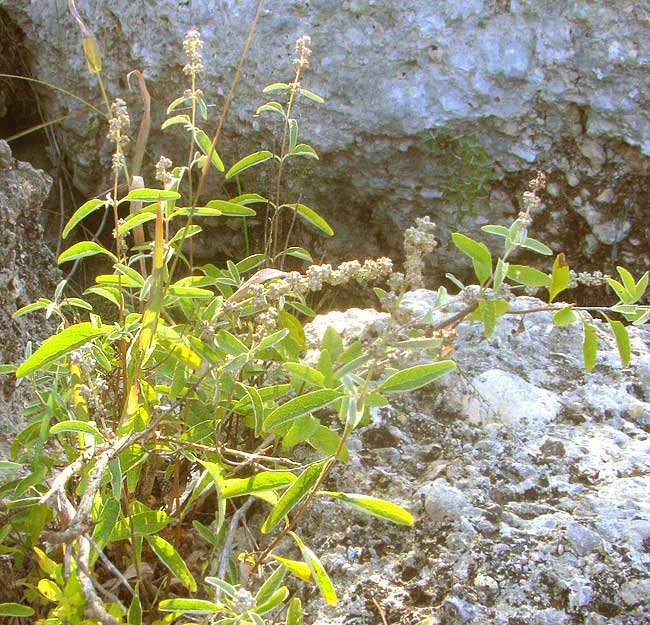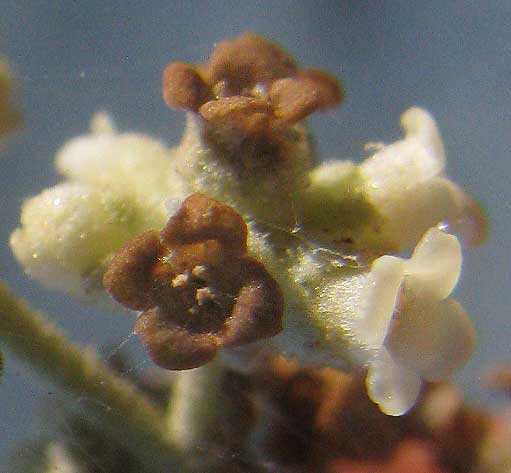Excerpts from Jim Conrad's
Naturalist Newsletter

from the September 8, 2013 Newsletter issued from the Frio Canyon Nature Education Center in the valley of the Dry Frio River in northern Uvalde County, southwestern Texas, on the southern border of the Edwards Plateau; elevation ~1750m (~5750 ft); N29.62°, W99.86°; USA
TEXAS BUTTERFLYBUSH
In cracks of large limestone boulders strewn along the Dry Frio River, several knee-high, soft-woody, much branched bushes turned up, shown above. It was hard to imagine how the plants found enough moisture to survive. In fact, once I looked around, most plants bore curling-up leaves, as shown below:

There you can see that the plant's leaf surfaces are dark green, but their undersurfaces are white with tiny, branched or "stellate" hairs. The curling causes the leaves' better protected undersurfaces to wrap around the more vulnerable upper surface. The undersurface's whiteness reflects sunlight bouncing off the limestone below it, and probably the hairs help dissipate heat, as well. Nice adaptations.
At first, from the bush's general form, the opposite leaves and leaf shape, I thought the plant might belong to the Mint or Verbena Families. However, the stems aren't in the least squarish in cross-section, and a quick glance at the tiny (1/16th-inch, or 1.5mm) flowers dispelled any notion of the plant belonging to those families, as you can see below:

The brown flowers are pollinated ones in the process of shriveling and falling off; the whitish ones are fresh. After several minutes of unsuccessfully trying to remember which families could produce leaves and stems like this, along with radially symmetrical, four-lobed corollas and four stamens, finally it occurred to me that I'd seen such terminal inflorescences with their widely spaced clusters of flowers and fruits before -- on ornamental "butterflybushes," mainly Buddleja davidii from central China. But the ornamental butterflybushes are much larger than our boulder-growing bush, and with larger, colorful, fragrant flowers.
Still, I couldn't think of anything else halfway similar to our rock bushes, so I checked to see if any Buddlejas occurred in Texas. And, by golly, there are, and one of them not only occurs in our area but also looks exactly like our plant.
In books it's known as the Texas Butterflybush or Wand Butterflybush. It's BUDDLEJA RACEMOSA, endemic to the Edwards Plateau in Texas. Two varieties are recognized, one on the Plateau's eastern end, the other on the western. The eastern variety, the typical one, is only sparsely hairy below, while the western variety -- where we are --is densely hairy, or "appressed stellate-tomentose," as the Flora of North America says. Our western variety is Buddleja racemosa var. incana. Most pictures on the Internet show the less hairy eastern variety because that's where San Antonio is. You must travel into the backcountry to find our variety incana.
Butterflybushes in the genus Buddleja have been shifted from family to family, but now the gene sequencers seem to have settled it comfortably in the Snapdragon or Figwort Family, the Scrophulariaceae.
What a pleasure to find such a little-known species so exquisitely adapted to our little part of the world! And what a surprise that it's so closely related to gaudy ornamental butterflybushes.